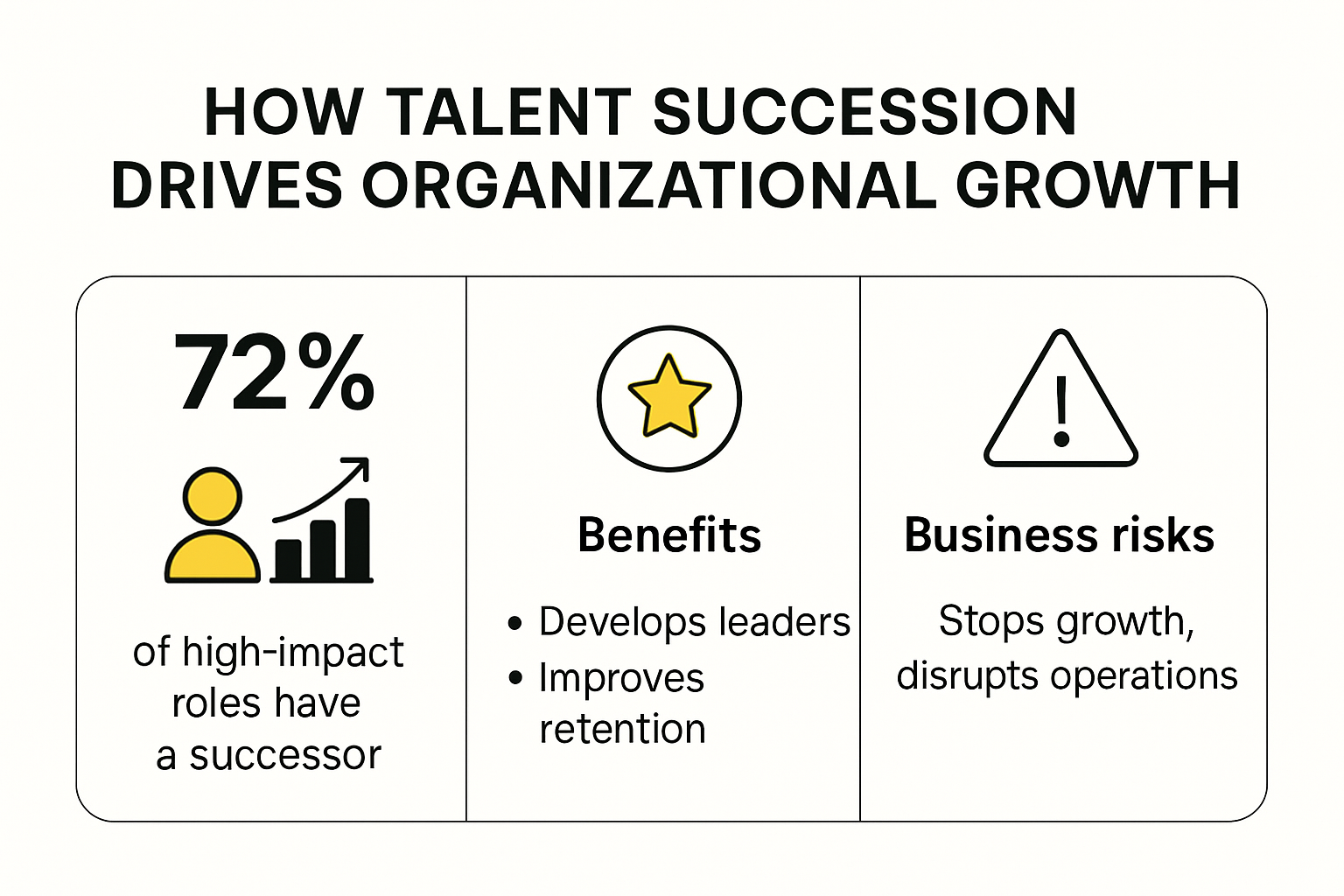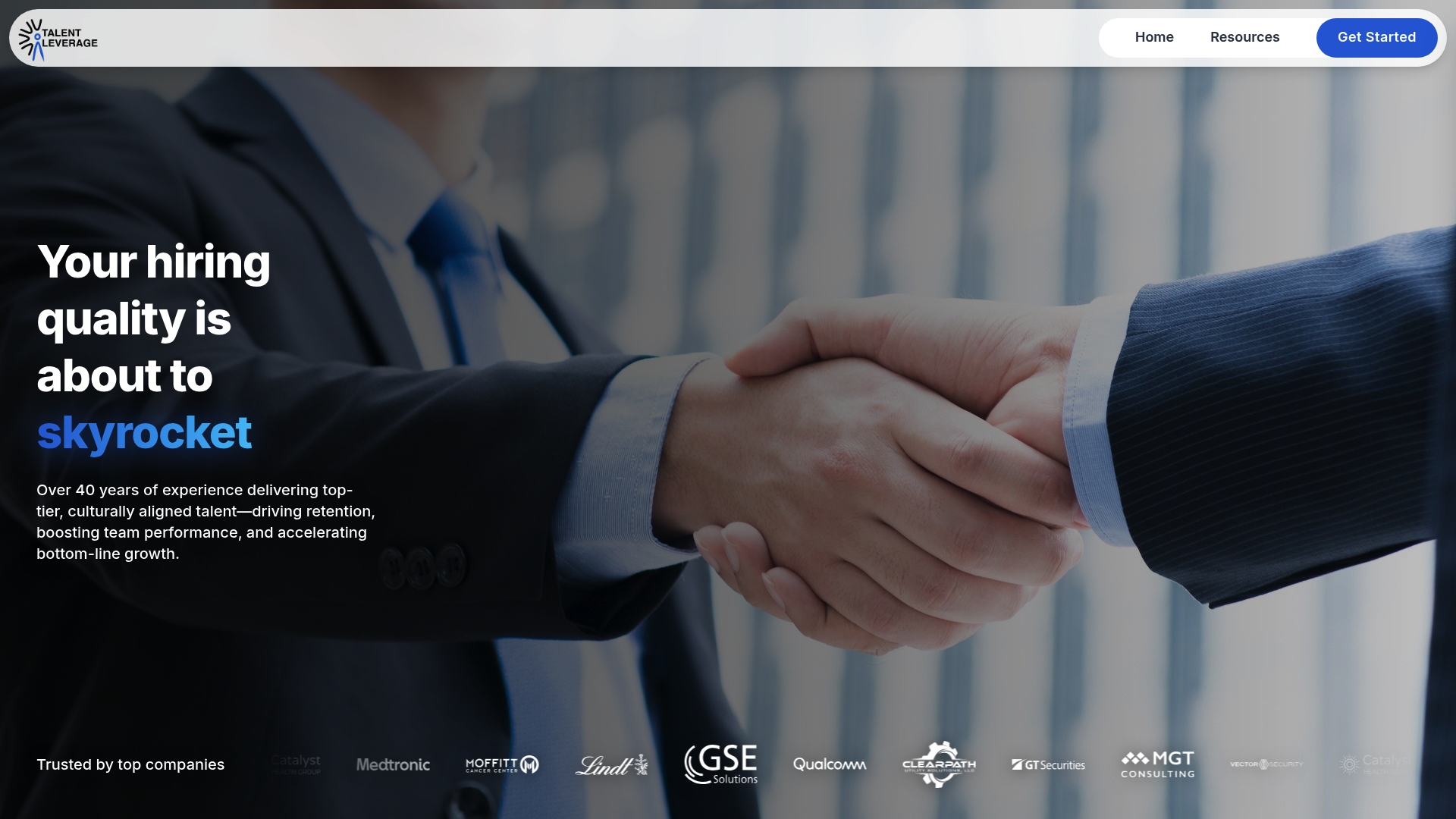
Succession planning might sound like a technical HR task, but the reality is far more urgent for high-growth companies facing 2025. Only 54 percent of business owners actually have a solid succession plan in place, leaving nearly half exposed to costly knowledge loss and leadership gaps. You might assume filling key roles is just about finding the next qualified person at the right time. The surprising truth is that proactive talent succession is what separates organizations that thrive from those that stumble during a shakeup. For companies chasing growth, building a dynamic pipeline of internal leaders is not just useful, it is now a frontline competitive advantage.
Table of Contents
- Why Talent Succession Strategies Drive Growth
- Key Steps To Build A Succession Pipeline
- Industry-Specific Challenges And Solutions
- How Local Talent Markets Impact Succession
Quick Summary
| Takeaway | Explanation |
|---|---|
| Proactive Succession Planning is Critical | Effective talent succession strategies should be prioritized to avoid leadership vacuums and productivity disruptions when unexpected departures occur. |
| Continuous Development is Essential | Organizations should invest in ongoing talent development to prepare employees for future leadership challenges, thus creating competitive advantages. |
| Tailored Approaches for Industry Challenges | Succession strategies need to be adapted to address unique challenges and dynamics specific to different industries such as technology, manufacturing, and healthcare. |
| Leverage Local Talent Markets | Understanding geographic talent availability and local market dynamics enables companies to create more effective and resilient succession strategies that align with regional strengths. |
| Dynamic Succession Frameworks Are Necessary | Organizations must create agile and flexible succession frameworks that can respond to changing market conditions, technological advancements, and skill requirements. |
Why Talent Succession Strategies Drive Growth
Business growth hinges on one critical factor: strategic talent management. High-performing organizations understand that talent succession strategies are not just HR formalities but fundamental drivers of organizational resilience and competitive advantage.

The Strategic Imperative of Proactive Succession Planning
In 2025, the stakes for talent management have never been higher. Research from leadership experts reveals a striking statistic: 69% of directors believe sudden departures of key leaders can significantly disrupt organizational performance. This underscores why succession planning has become a top boardroom priority.
The data tells a compelling story. Only 54% of business owners currently have a robust succession plan in place, creating a massive vulnerability in organizational continuity. Companies without strategic talent succession strategies risk:
- Leadership Vacuum: Unexpected departures can create prolonged periods of uncertainty
- Knowledge Loss: Critical institutional knowledge walks out the door with top performers
- Productivity Disruption: Unplanned transitions can slow down critical business operations
Building Organizational Resilience Through Strategic Talent Development
Succession strategies are more than replacement planning. They represent a holistic approach to talent development that transforms potential disruptions into opportunities for growth. By learning more about our talent acquisition solutions, organizations can create dynamic pipelines of internal talent ready to step into critical roles.
The most successful companies view talent succession as a continuous process of identifying, developing, and retaining high-potential employees. This approach does more than mitigate risk it actively creates competitive advantages. Organizations with robust succession strategies experience:
- 50% faster leadership transitions
- 30% higher retention of top talent
- Improved organizational agility and adaptability
What separates top-performing companies is their commitment to viewing talent as a strategic asset. They invest in comprehensive development programs that prepare employees not just for current roles but for future leadership challenges. This forward thinking approach ensures that when critical transitions occur, the organization remains stable and continues to drive momentum.
In 2025, talent succession is no longer optional. It is a critical strategy for companies looking to navigate complex business landscapes, retain institutional knowledge, and maintain competitive edge. Companies that prioritize strategic talent development will be the ones that not only survive but thrive in an increasingly dynamic business environment.
Key Steps to Build a Succession Pipeline
Building a robust talent succession pipeline requires strategic planning and deliberate execution. Organizations must transform traditional talent management approaches into dynamic, forward-looking strategies that anticipate future leadership needs.
Identifying and Mapping Critical Leadership Roles
The first critical step in creating an effective succession pipeline involves comprehensive role mapping and potential identification. Organizational development experts emphasize that defining key leadership roles and responsibilities forms the foundation of successful succession planning.
This process demands more than simply listing job titles. Companies must conduct deep analysis to understand:
- Strategic Capabilities: What skills will be critical for future organizational success?
- Performance Potential: Who demonstrates exceptional adaptability and learning agility?
- Cultural Alignment: Which candidates embody the organization’s core values and vision?
Developing High-Potential Talent Through Targeted Programs
Identifying potential successors represents only the beginning. Research on talent development highlights that implementing targeted development programs is crucial for equipping future leaders with necessary skills and knowledge.
Effective development strategies include:
- Customized leadership training modules
- Mentorship programs with current executive leadership
- Cross-functional exposure and rotation opportunities
- Stretch assignments that challenge and expand candidate capabilities
Creating Transparent and Motivational Succession Frameworks
Successful succession planning requires transparency and genuine commitment to employee growth. Organizations must create clear pathways that demonstrate investment in their top talent. Learn more about our talent acquisition solutions to understand how strategic approaches can transform talent development.
Key elements of motivational succession frameworks include:
- Clear communication about advancement opportunities
- Performance-based progression metrics
- Regular feedback and developmental conversations
- Recognition and rewards for high-potential performers

Building a succession pipeline is not a one-time event but a continuous, dynamic process. It demands ongoing assessment, adaptation, and genuine commitment to developing internal talent. Organizations that master this approach will create resilient, adaptable leadership teams capable of navigating complex business challenges.
By investing in systematic talent development, companies transform potential disruptions into opportunities for growth. The most successful organizations view their talent pipeline as a strategic asset—constantly nurtured, carefully developed, and aligned with long-term organizational objectives.
Industry-Specific Challenges and Solutions
Talent succession strategies are not universal. Each industry presents unique challenges that demand nuanced approaches to leadership development and talent management. Understanding these sector-specific dynamics is crucial for building resilient organizational pipelines.
Technology and SaaS: Navigating Rapid Innovation
Research from leadership experts reveals that technology sectors face distinctive succession challenges. With innovation cycles accelerating, companies must develop leaders who can not only manage current technologies but anticipate and drive future transformations.
Key challenges in technology succession include:
- Skill Obsolescence: Rapid technological changes require continuous learning
- Talent Retention: High-demand professionals are constantly courted by competitors
- Innovation Leadership: Finding leaders who balance technical expertise with strategic vision
Manufacturing and Engineering: Bridging Knowledge Gaps
Manufacturing and engineering sectors confront unique succession challenges rooted in technical complexity and institutional knowledge. Industry talent management strategies emphasize the importance of structured knowledge transfer and early identification of high-potential talent.
Effective solutions for these industries include:
- Comprehensive mentorship programs
- Technical skill documentation processes
- Cross-generational knowledge sharing initiatives
- Explore our industry-specific recruitment strategies to understand deeper talent acquisition approaches
Healthcare and Life Sciences: Regulatory and Expertise Challenges
Healthcare and life sciences industries demand exceptional succession strategies due to complex regulatory environments and highly specialized skills. Talent management research highlights the need for transparent, data-driven processes that align leadership development with stringent industry requirements.
Critical succession considerations include:
- Compliance and regulatory knowledge transfer
- Advanced clinical and research leadership development
- Succession planning that maintains institutional research continuity
Successful industry-specific succession strategies recognize that talent development is not a one-size-fits-all approach. Organizations must design targeted programs that address unique sector challenges while maintaining flexibility and innovation.
The most adaptive companies will create succession frameworks that are not just reactive but predictive. By understanding industry-specific talent dynamics, organizations can build leadership pipelines that are robust, forward-thinking, and strategically aligned with emerging market demands.
How Local Talent Markets Impact Succession
Local talent markets are dynamic ecosystems that profoundly influence organizational succession strategies. High-growth companies must recognize that talent acquisition and development are deeply interconnected with regional economic landscapes, educational ecosystems, and industry-specific talent pools.
Geographic Talent Availability and Skill Ecosystems
Research on succession planning reveals that one-third of directors recognize local talent markets as critical determinants of leadership continuity. Different regions offer unique talent advantages and challenges that directly impact succession planning strategies.
Key geographic considerations include:
- Urban Innovation Hubs: Metropolitan areas like San Francisco, New York, and Chicago provide concentrated talent pools in technology and finance
- Regional Economic Specializations: Areas with strong industry concentrations develop specialized talent ecosystems
- Educational Institution Partnerships: Local universities and technical colleges shape regional talent development
Skill Mapping and Local Market Dynamics
Talent management experts emphasize the importance of continuously assessing local talent market shifts. Organizations must develop flexible succession strategies that adapt to changing skill requirements and regional talent landscapes.
Effective local talent market strategies involve:
- Regular skills gap analysis
- Collaborative relationships with local educational institutions
- Customized training and development programs
- Learn about our targeted recruitment approaches to understand regional talent acquisition nuances
Technology and Talent Market Transformation
Industry research indicates that technological advancements are rapidly reshaping local talent markets. Remote work, digital skill requirements, and emerging technologies are creating new paradigms for talent succession planning.
Critical technological considerations include:
- Impact of remote and hybrid work models
- Emerging digital skill requirements
- Cross-regional talent mobility
- Technological infrastructure supporting talent development
Successful organizations view local talent markets not as static environments but as dynamic ecosystems requiring continuous monitoring and strategic adaptation. By understanding regional talent dynamics, companies can develop nuanced succession strategies that leverage local strengths while preparing for future skill transformations.
The most forward-thinking organizations will create agile succession frameworks that are responsive to local market shifts, technological disruptions, and emerging talent trends. This approach ensures not just leadership continuity but sustained competitive advantage in an increasingly complex business landscape.
Frequently Asked Questions
What is talent succession planning?
Talent succession planning is a strategic approach for identifying and developing internal personnel who have the potential to fill key leadership roles within an organization. It is essential for maintaining organizational continuity and mitigating the impact of unexpected departures.
Why is succession planning important for high-growth companies?
Succession planning is crucial for high-growth companies because it helps prevent leadership vacuums, retains critical institutional knowledge, and ensures smooth transitions in leadership. This proactive approach can enhance organizational resilience and competitive advantage.
How can companies identify high-potential talent?
Companies can identify high-potential talent through comprehensive role mapping, performance evaluations, and assessments of strategic capabilities, adaptability, and cultural alignment with the organization. This process should focus on employees who demonstrate leadership qualities and alignment with future organizational goals.
What are some effective strategies for developing future leaders?
Effective strategies for developing future leaders include customized leadership training, mentorship programs, cross-functional exposure, and stretch assignments that challenge candidates and expand their capabilities. Investing in ongoing talent development prepares employees for leadership challenges ahead.
Secure Your Company’s Future Leadership—Partner with Experts in Succession and Growth
Struggling with unexpected leadership gaps or worried about losing top talent when it matters most? Many fast-growing US companies face these same pain points, as highlighted in our recent exploration of proactive succession strategies. When organizational knowledge walks out the door, the cost to growth and stability is real. Visit our Business Solutions page to see how leading companies overcome these challenges before they impact results.

Stay one step ahead by transforming your approach to talent succession. With Talent Leverage’s experience across 16 specialized industries, you get a partner who knows how to map critical leadership roles and develop high-potential talent for long-term advantage. Discover how our flexible hiring models and nationwide reach can build the resilient pipeline your business needs. See the results for yourself or connect with our team now to build a future-proof talent strategy that keeps your company thriving. Don’t wait for disruption—make succession your new edge.


